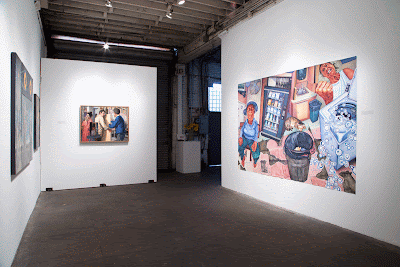Mahara Sinclaire July 7
CURATOR’S STATEMENT
Mahara T. Sinclaire
Lazy Susan II: ConFiguring LA (What’s the Story?)
Sunday, July 7, 2013, 7:00-9:00pm
PØST
1904 East 7th Place, LA, CA 90021 www.postlosangeles.org
F.Scott Hess
Max Presneill
Mahara T. Sinclaire
Norland Tellez
Eloy Torrez
John Valadez
Lazy Susan II: ConFiguring LA (What’s the Story?) is the second in an ongoing series of independent curatorial projects that highlight a loose confederation of LA artists orbiting around a specific theme, here, open-ended narrative strategies in figuration. The overarching intent of the project is to point to the consistent thread of figurative artists that comprise a significant strand in the continuing art historical fabric of the LA art scene.
As global cultural traditions migrate, transition and gain traction, we find in Los Angeles an increasing embrace of the predominant Hispanic perspective, an aesthetic that has historically held well-crafted figuration with a narrative impulse in high regard. It is in this hopeful soil that contemporary LA figurative artists may find a welcome celebration and increased valuation of LA’s rich figurative vein.
This embrace of narrative figuration is exemplified in the work of Norland Tellez as he retells the ancient Mayan Popul Vu mythic lore, adding his own interpretation to the arcane text. By reinvestigating this ancient narrative, Tellez aspires to unlock its hidden meaning which has resisted a Eurocentric co-option due to its layered metaphors as Tellez posits in his recent dissertation.
F. Scott Hess’ work characteristically addresses the separate psychological postures of the world of men and the world of women. His works tell of the artist’s solitary existence of hours on end in the studio at home as a separate but conjoined experience with that of his wife and daughters. Issues of control and power within these gendered dynamics are reinforced with compositional devices which lock in this sense of rigid, immovable roles. His upcoming retrospective, to be held in part at Los Angeles Municipal Art Gallery will be a welcome celebration of his indelible mark as one of our finest masters of figuration as Donald Kuspit has emphatically made the case.
Max Presneill’s work reinvigorates political narrative and often mines Norse and Greek mythology. Asserting that identity is constantly in flux as it is reliant on memory which morphs with each retelling, this unreliability distorts fact to fiction and makes meaning impossible to pin down. His painting of the bust of George Washington articulates that the realities of personage are not reflected in the icons. His series of busts function like chess set pieces imbued with attributes arrived at through a shared investment of agreed-upon meaning. His Gilgamesh bust painting looks to the first historically-attributed work of fiction, paralleling the narrative’s quest to understand death with the act of art-making as essentially a drive for immortality. Fundamentally, Presneill’s works epitomize this state of constant flux as he continually reworks the canvases, never to arrive at a crystalized outcome (death).
Eloy Torrez has long participated in the LA art scene with striking murals that honor Latino personalities that have contributed to the fabric of Los Angeles and Hollywood’s legacy. Recent works capture Hispanic individuals in casual Southern California scenarios as well as narratives that evince mythic and symbolic underpinnings.
John Valadez posits the Latino perspective as the dominant narrative. In seemingly freeze-frame moments, his compositions capture Latino-centric societal experience to point to the specificity of Latino self-image and identity-construct while simultaneously demonstrating the ubiquitous, main-stream narrative of banal American-ness. As the figures participate in often stereotypical middle-class behaviors and outings, their American-ness is underscored. The viewer has the sense that once she/he leaves the work, the freeze-frame will melt, and the narrative will resume independent of the viewer’s gaze.
Mahara T. Sinclaire’s work also emphasizes narrative figuration to comment on societal experience. Sinclaire uses self-portraiture to inhabit the various characters in her work, cobbling together the figures with source material digital shots of her own body parts. The work’s focus is psychological candor and addresses the emotional predicament of contemporary urban experience. Her characters stand-in for us all and examine the psychological duress engendered by contemporary life.
Looking at the configuration of the LA art scene, this Lazy Susan II: ConFiguring LA (What’s the Story?) curatorial project points to the significant art historical and on-going importance of the figurist vein, paying particular attention to the role of open-ended narrative as a powerful strategy in the implementation of these works.













